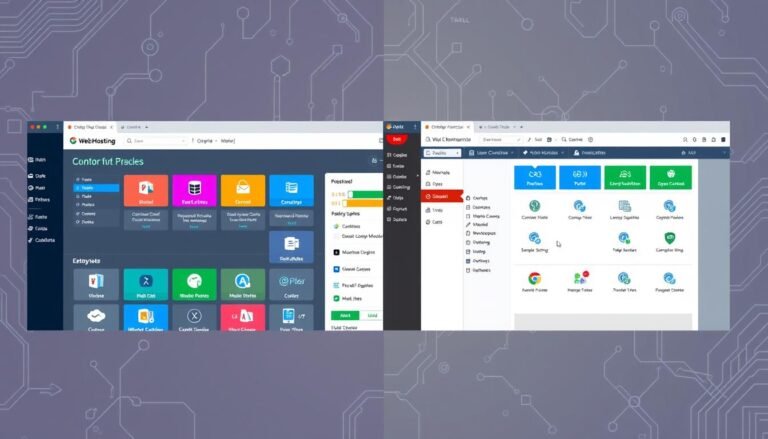Top Features of cPanel vs. Plesk Hosting for Developers
Hosting for Developers Selecting the appropriate hosting control panel is a critical choice that can significantly impact developers aiming to optimize their projects, whether for a small business or larger enterprises.
This article delves into the standout features of cPanel and Plesk, emphasizing the unique offerings of each platform in terms of user interface, essential functionalities, security protocols, customization options, and pricing structures.
For those interested in API access, scripting options, or comprehensive server management tools, a thorough examination of the key differences is presented, guiding readers toward the control panel that best aligns with their development requirements and technical comfort level.
Key Takeaways: Hosting for Developers
- cPanel and Plesk both offer advanced features that appeal to developers, such as API access and server management tools.
- Plesk offers a more user-friendly interface, while cPanel is known for its robust and customizable features.
- When it comes to pricing, cPanel is generally more affordable, while Plesk offers more flexibility with its tiered pricing structure.
Understanding Hosting Control Panels
Hosting control panels serve as essential components of any web hosting solution, offering users a sophisticated interface for efficient site management. These tools facilitate a range of operations, including server management, database setup, and email account configurations, all of which significantly elevate the overall hosting experience.
A comprehensive understanding of platforms like cPanel and Plesk enables developers to optimize their workflows, manage virtual private servers, and ensure seamless performance across their projects.
With features such as one-click app installations, automated backups, and in-depth analytics, these control panels give the power to users to maintain their websites effortlessly. For example, the capability to monitor resource usage in real time allows developers to pinpoint bottlenecks, enabling timely interventions.
Moreover, integrated security measures—such as SSL certificate management and firewall settings—provide robust protection against potential threats, safeguarding a stable online presence. Ultimately, the efficiency and effectiveness of site management are markedly enhanced, allowing developers to concentrate on creating high-quality content rather than becoming mired in technical details.
Comparative Overview: cPanel vs. Plesk and Their Hosting Features
When comparing cPanel and Plesk, one must consider their distinct strengths and weaknesses, as both control panels are designed to meet a range of user needs and varying levels of technical expertise. cPanel is predominantly admired for its intuitive, user-friendly interface, which simplifies tasks such as FTP protocols and database management. In contrast, Plesk distinguishes itself with robust support for the Windows operating system and advanced features, including Git integration and Docker management. A deep understanding of these differences can significantly influence developers’ efficiency and overall hosting experience.
Beyond their design philosophies, usability encompasses how each panel interacts with diverse environments and web technologies. cPanel is frequently regarded as the preferred choice for Linux users, offering seamless integration with PHP and MySQL. Meanwhile, Plesk’s versatility enables users to navigate proficiently across multiple platforms, providing support for Node.js and Python.
While cPanel boasts an extensive array of plugins to enhance its functionality, Plesk stands out with built-in automation tools that streamline workflows for developers. This not only cultivates a more efficient development cycle but also enhances collaboration among team members, positioning Plesk as a valuable choice for project-driven environments.
User Interfaces
The user interface of a hosting control panel significantly shapes the overall web hosting experience, profoundly impacting how effectively developers manage their websites. cPanel has earned a reputation for its simplicity and user-friendly design, catering to those who prefer a straightforward approach to site management.
In contrast, Plesk presents a more contemporary interface, replete with extensive features that attract developers operating across various environments, including both Linux and Windows operating systems.
A careful analysis of these interfaces is essential for discerning which control panel most effectively aligns with specific needs, ultimately ensuring optimal performance.
cPanel User Interface
The cPanel user interface is widely praised for its intuitive design, which renders it accessible to both novice users and seasoned developers alike, facilitating efficient management of web hosting needs. Its organized layout allows users to navigate effortlessly through a variety of features, including FTP protocols, email accounts, and one-click installations for popular applications such as WordPress. This simplicity significantly enhances the site management process, enabling developers to concentrate on building and maintaining their websites with minimal hassle.
The dashboard prominently showcases essential tools and shortcuts, effectively reducing the time spent searching for specific functionalities. Key features such as file management, database administration, and security settings are conveniently located just a click away, streamlining tasks that might otherwise require considerable effort.
For those juggling multiple projects, cPanel’s ability to create subdomains and manage various domains from a single interface proves invaluable.
This user-friendly environment not only addresses the immediate needs of developers but also cultivates a more productive workflow, ultimately supporting the long-term success of their online ventures and hosting services.
Plesk User Interface
Plesk’s user interface is meticulously crafted to cater to a diverse array of users, providing a modern and highly customizable experience that significantly enhances web hosting management. Its dashboard facilitates swift access to essential features, including server configurations, domain management, and plugin management for advanced functionalities.
This impressive flexibility, coupled with a strong emphasis on performance, positions Plesk as a favored choice for developers seeking tailored solutions in both Linux and Windows environments.
The interface permits personalized layouts and themes, allowing users to curate a workspace that reflects their individual preferences and workflows. With its intuitive navigation, Plesk give the power tos even those with limited technical expertise to manage their projects and applications efficiently.
Performance-oriented features, such as resource monitoring and automated tasks, equip developers to optimize their server configurations with ease, addressing specific demands seamlessly.
By integrating essential tools, Plesk not only streamlines tasks but also significantly enhances overall productivity, rendering it a robust platform for effortlessly managing multiple sites.
Core Features

The core features of hosting control panels are what set cPanel and Plesk apart, positioning them to meet the diverse needs of users and web hosting requirements. Both platforms deliver essential functionalities such as site backups, security measures, DNS settings, and email account management; however, each excels in distinct areas.
For instance, cPanel is often preferred for its user-friendly interface and efficient WordPress management, while Plesk stands out with advanced capabilities, including Git integration, multi-server management, and plugin management, making it particularly appealing to developers with varying demands.
Features of cPanel
cPanel presents an impressive array of features meticulously crafted to elevate the web hosting experience, particularly for those who seek an intuitive and user-friendly platform. Among its key functionalities are streamlined WordPress management, comprehensive backup solutions, and efficient site management tools designed to simplify essential tasks, such as database configuration and email account setup. These attributes are critical for developers who prioritize both performance and usability in their hosting endeavors.
Moreover, developers can leverage one-click application installers that facilitate the swift setup of popular web applications, significantly enhancing project turnaround times. The integrated file manager provides a user-friendly interface for managing site files directly, allowing for seamless uploads and edits without the need for third-party FTP clients.
Additionally, the built-in analytics tools offer valuable insights into website traffic and performance, give the power toing developers to make informed, data-driven decisions that enhance user experiences. Robust security features, including SSL certificate management, ensure that sites remain secure and trustworthy—an essential requirement in today’s digital landscape.
Features of Plesk
Plesk’s feature set is meticulously crafted to cater to the sophisticated needs of modern developers, presenting a comprehensive array of tools that streamline web hosting management and FTP protocols. Among its impressive offerings are advanced security measures, including automatic SSL certificate installations and regular site backups, which collectively enhance site protection and reliability. Additionally, WordPress management capabilities streamline operations for popular CMS platforms.
Plesk’s robust support for Docker and Git integration give the power tos developers to manage applications and deploy code with remarkable efficiency, establishing it as an optimal choice for those well-versed in technology.
The platform’s intuitive interface demystifies complex tasks, enabling both experienced developers and novices to navigate effortlessly, thereby mitigating the learning curve. Features such as One-Click Installation for popular applications facilitate rapid deployment, while the built-in firewall, fail2ban functionality, and DNS settings offer real-time defense against malicious attacks.
By allowing developers to schedule automatic backups, Plesk guarantees that their efforts remain secure without requiring manual oversight. These synergistic advantages not only amplify performance and productivity but also significantly elevate the overall workflow, rendering Plesk a critical tool for managed server and domain configurations for any development endeavor.
Security Features
In the realm of web hosting, security features stand as a cornerstone of reliable service, with both cPanel and Plesk offering formidable measures to shield users’ websites from vulnerabilities and attacks.
cPanel gives users access to fundamental security tools, including IP blocking, password protection, Email forwarding, and SSL certificate management, all of which contribute to secure site management.
Conversely, Plesk elevates security with advanced features such as fail2ban for intrusion prevention and integrated security scans, rendering it a compelling option for developers working in both Linux environment and Windows OS who prioritize the safeguarding of their applications.
cPanel Security Measures
cPanel provides users with an extensive array of security measures designed to fortify their web hosting environments and safeguard sensitive data. Key features include SSL certificate management, which ensures secure connections, IP blocking to thwart unauthorized access, and automated backup options that protect website content from potential data loss. Such comprehensive security measures give the power to developers to manage their websites with unwavering confidence, assured that their data remains secure.
The security features inherent in cPanel, such as password-protected directories, allow developers to restrict access to sensitive areas of their websites, while supporting Python, Ruby on Rails, and Perl, thereby enhancing data protection further. Tools like CSF (ConfigServer Security & Firewall) enable users to monitor and manage incoming traffic, making it compatible with Apache server and PHP, effectively neutralizing potential threats before they compromise their systems.
Regular software updates including MySQL and phpMyAdmin and vulnerability scans are vital for identifying and addressing risks, underscoring the necessity for developers to remain vigilant. Collectively, these security protocols not only safeguard valuable data but also enhance the reliability of websites, ultimately fostering a more stable online presence.
Plesk Security Measures
Plesk presents an impressive suite of advanced security measures tailored specifically for developers in need of formidable protection for their applications and data.
Its capabilities transcend mere basic firewalls, incorporating tools such as ModSecurity, a powerful web application firewall designed to thwart prevalent threats like SQL injection and cross-site scripting in databases and cross-site scripting. The addition of Let’s Encrypt facilitates automatic SSL certificate issuance, ensuring that data transmission remains secure and encrypted. Furthermore, regular automated backups bolster security, permitting swift recovery from unforeseen incidents, aided by backup restoration features.
By integrating these sophisticated features, users can confidently focus on their innovative pursuits, assured that their web applications are well-protected against a myriad of cyber threats.
Backup and Restoration Options

Backup and restoration options are critical components of any web hosting control panel, designed to give the power to developers to safeguard their site data and facilitate recovery in the event of loss or corruption. cPanel presents a user-friendly backup management system, enabling users to swiftly create full or partial backups of their websites.
In contrast, Plesk delivers a more advanced suite of backup options and subscription management, including scheduled backups and a streamlined restoration process, allowing developers to effortlessly maintain site integrity and security.
Both platforms prioritize user accessibility, catering to individuals who may lack extensive technical expertise. For example, cPanel’s intuitive interface with mobile access guides users through the backup process with minimal effort, while its restoration feature enables quick recovery, significantly reducing downtime.
Conversely, Plesk simplifies the scheduling process by offering automatic backup options, a critical feature for businesses that depend on consistent uptime.
These robust features not only diminish the risk of data loss but also enhance overall site security, allowing developers to concentrate on building and expanding their websites without the constant concern of potential data loss.
Performance Optimization
Performance optimization stands as a pivotal aspect of web hosting, profoundly influencing the speed and reliability of applications. Both cPanel and Plesk present an array of tools and functionalities aimed at enhancing server performance, thereby ensuring that websites operate seamlessly.
cPanel offers a suite of options for optimizing server configurations and leveraging the capabilities of CloudLinux OS for superior resource management. Meanwhile, Plesk provides developers the flexibility to adjust settings tailored to specific performance requirements, positioning itself as a versatile choice for those dedicated to refining their hosting experience, especially with hosting providers like Bluehost, SiteGround, A2 Hosting, and HostGator.
For example, cPanel’s caching mechanisms and Apache optimization give the power to users to significantly reduce load times by storing frequently accessed data. On the other hand, Plesk’s integrated support for caching solutions like Varnish can further amplify performance. Both platforms facilitate monitoring of resource usage, enabling the identification of bottlenecks and improving CloudLinux OS performance and fostering data-driven decisions that enhance speed.
Developers can adeptly leverage these capabilities to fine-tune their applications, ensuring a seamless user experience and bolstering reliability amidst fluctuating traffic conditions.
Pricing Structure
The pricing structure of hosting control panels emerges as a crucial factor for developers working within Linux and Windows systems aiming to strike an effective balance between features and costs.
cPanel typically presents a pricing model that fluctuates based on the number of accounts and specific features required, rendering it a versatile choice for both small businesses and large enterprises.
In contrast, Plesk employs a tiered pricing system that accommodates diverse needs, enabling hosting companies to deliver customized solutions for their clients.
A thorough understanding of these pricing frameworks give the power tos developers to select the control panel that aligns seamlessly with their budgetary constraints and project requirements.
cPanel Pricing Overview
cPanel’s pricing model is crafted to serve a diverse spectrum of users, ranging from small businesses to large enterprises, establishing it as a versatile option in the web hosting arena. The cost fluctuates according to the number of accounts needed and the features included, give the power toing developers to choose plans that align perfectly with their specific needs and budgetary constraints. This inherent flexibility enables hosting companies to present competitive pricing while upholding a commitment to high-quality service.
The various tiers encompass essential features such as backups, security enhancements, and user management, with higher-level plans unlocking advanced functionalities like sophisticated analytics and tailored resources. This tiered structure permits developers to initiate their journey with a basic plan and scale according to their projects’ growth, ensuring they only invest in what they genuinely require.
Hosting companies reap the benefits of this model, as it allows them to address the needs of a diverse clientele without inundating them with superfluous features, ultimately enhancing customer satisfaction and fostering long-term retention.
Also Read: cPanel vs. Plesk for VPS Hosting: What’s the Difference?
Plesk Pricing Overview
Plesk utilizes a tiered pricing structure that give the power tos hosting companies to deliver tailored solutions aligned with their clients’ unique needs. Each tier encompasses an array of features, including advanced security measures and multi-server management, rendering it an exceptionally versatile choice for developers.
This pricing model offers both flexibility and scalability, ensuring users can identify a plan that meets their specific requirements while staying mindful of budget constraints.
For example, the entry-level tier is designed to cater to small businesses, equipped with essential features such as basic security, single-server management, and WordPress management, making it ideal for those embarking on their journey.
Conversely, mid-tier options attract larger firms by providing enhanced tools for automation, backup solutions, and developer tools—capabilities that developers often seek for more complex projects. The top-tier offerings are tailored for enterprises that demand cutting-edge technology, complete with robust security, multi-site management, and DNS settings functionalities.
This strategic structure not only enables hosting companies to optimize their service offerings but also bolsters their competitive advantage, allowing them to effectively serve a diverse clientele, including those using Apache server, WordPress, and Docker.
FAQs
What are the top features of cPanel for developers?
Some of the top features of cPanel for developers include API access, advanced scripting capabilities, server management tools, and WordPress Toolkit.
Can I access API in cPanel for development purposes?
Yes, cPanel offers API access for developers to integrate their own applications and automate tasks.
What scripting languages does cPanel support?
cPanel supports a wide range of scripting languages, including PHP, Perl, Python, Ruby on Rails, and more, making it a versatile platform for developers.
How does Plesk compare to cPanel in terms of server management tools?
Plesk offers similar server management tools as cPanel, but with a more user-friendly interface and support for Windows servers, as well as Linux environment compatibility.
What advantages does Plesk offer for developers?
Plesk offers a unique feature called “Git Integration,” which allows developers to easily deploy code changes and manage versions directly from the control panel, leveraging Git and Docker capabilities.
Is there a significant difference between cPanel and Plesk for developers?
While both cPanel and Plesk offer advanced features for developers, their key differences lie in the user interface and the operating systems they support (cPanel for Linux and Plesk for both Linux and Windows OS, including CloudLinux OS). Ultimately, it comes down to personal preference and the specific needs of the developer.







